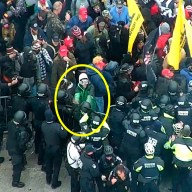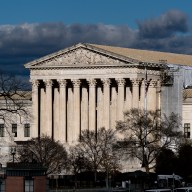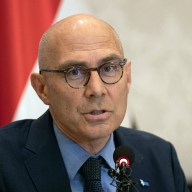The billionaire founder of Canada’s Cirque du soleil will rocket to international attention after blasting off into outer space to host one of the most unique spectacles in human history.
The fact that Guy Laliberte becomes, over the next two weeks, Canada’s first-ever commercial space tourist is hardly a big deal considering what else he has in store.
It’s the star-studded show he intends to host from outer space – with concerts in 14 different cities featuring rock stars like U2 and Shakira, and former U.S. vice-president Al Gore – that will grab headlines far beyond this country’s borders.
Laliberte is already notorious for throwing some of the world’s wildest parties. Now he’s set to host the biggest bash in the known universe.
It was a long career path that led the 50-year-old impresario to Wednesday’s launch from the Baikonur Cosmodrome in Kazakhstan.
He started as a street juggler and fire-eater and, because he was the best at math among his group of performing friends, Laliberte was put in charge of a little performing troupe that would eventually become the world-famous Cirque du soleil.
That business venture helped Laliberte become wealthy enough to plunk down $US35 million for a seat on an old Russian spacecraft and a stay aboard the International Space Station.
His travel mates on the trip to the space outpost are Russian cosmonaut Maxim Surayev and American astronaut Jeff Williams.
Laliberte, the seventh space tourist to blast off in a Russian Soyuz spacecraft, actually lucked out back in April and was offered a seat when another mission was scrubbed.
Before liftoff, Laliberte was asked whether he had any fears about his upcoming mission.
“I’m not scared of anything up there,” Laliberte told reporters at a pre-launch news conference. He said he has been consulting with his “old friend,” Canadian astronaut Julie Payette, who was at the launch site with 40 friends and family members.
A space-tourism executive who booked Laliberte’s flight said the traditional Russian Soyuz is the safest way to travel into orbit.
“Space flight is not a business that is without risk, so it would be unreasonable to say that this is a risk-free enterprise,” said Eric Anderson, the CEO of Space Adventures.
“But it is certainly true that this is the best way to go into space.”
Laliberte had to train for five months at Star City, outside Moscow, to prepare for what he calls his “poetic social mission.”
That 12-day mission kicks into high gear after the Quebec City native arrives for a stop aboard the space station, where he will be welcomed by Canadian astronaut Bob Thirsk.
The highlight of Laliberte’s nine-day stay on the giant orbiting lab comes on Oct. 9, when he hosts a worldwide show from space to raise awareness of water issues.
It’s linked to Laliberte’s One Drop Foundation, which he set up “to fight poverty around the world by providing sustainable access to water.”
The two-hour live artistic event will be presented in 14 cities around the world and will feature a variety of international musical performers as well as actors, filmmakers, and other friends of Laliberte.
“This is a crazy adventure because this is the first time that a show will be presented from the space station,” said Daniel Lamarre, the Cirque du soleil CEO.
“We have so many international artists that it’s helping us to generate interest.”
Laliberte will also try to keep the mood light while other astronauts conduct their serious scientific experiments. He’s bringing some red clown noses up to space, and he intends to share them with his new friends.
He will also be surrounded by plenty of photos of his children and family, which he has included among his five-kilogram luggage allowance.
“He asked each of his family members to give him something that will remind him of his five kids, his fiancee and other family members,” Lamarre said.
The return from space may be a little bumpy.
The Soyuz was first introduced in the mid-1960s and – although it has been re-designed over the years – it still has the kind of tiny landing module associated with NASA’s early Apollo flights.
Mario Ciaramicoli, a recent Canadian graduate of the International Space University, says the Soyuz remains the most reliable way of getting humans into space.
“(The Russians) haven’t dramatically changed their equipment,” he said in an interview.
“The basic principle hasn’t changed very much because it’s been working all this time,” said Ciaramicoli, who recently visited the Russian training centre in Star City.
The Soyuz capsule, which uses a parachute to soften its bumpy re-entry, has missed its landing target in the past.
“We heard the story about one capsule that went down on to a mountain,” Ciaramicoli said.
“It just rolled down the hill and, if that wasn’t enough, when they (the astronauts) got out, there were wolves in the middle of the forest waiting for them and they had to scare them away.”
















